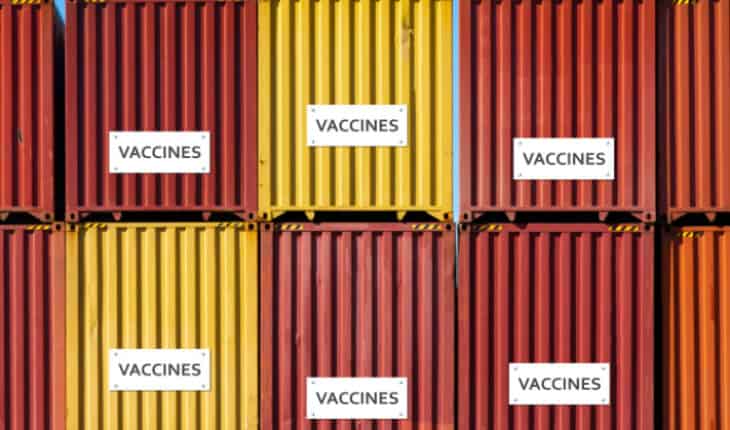Childhood immunization begins recovery after COVID-19 backslide: New WHO and UNICEF data show promising signs of immunization services rebounding in some countries, but, particularly in low-income countries, coverage still falls short of pre-pandemic levels putting children at grave risk from disease outbreaks.
Global immunization services reached 4 million more children in 2022 compared to the previous year, as countries stepped up efforts to address the historic backsliding in immunization caused by the COVID-19 pandemic.
According to data published by the World Health Organization (WHO) and UNICEF, in 2022, 20.5 million children missed out on one or more vaccines delivered through routine immunization services, compared to 24.4 million children in 2021. In spite of this improvement, the number remains higher than the 18.4 million children who missed out in 2019 before pandemic-related disruptions, underscoring the need for ongoing catch-up, recovery and system strengthening efforts.
The vaccine against diphtheria, tetanus and pertussis (DTP) is used as the global marker for immunization coverage. Of the 20.5 million children who missed out on one or more doses of their DTP vaccines in 2022, 14.3 million did not receive a single dose, so-called zero-dose children. The figure represents an improvement from the 18.1 million zero-dose children in 2021 but remains higher than the 12.9 million children in 2019.
“These data are encouraging, and a tribute to those who have worked so hard to restore life-saving immunization services after two years of sustained decline in immunization coverage,” said Dr Tedros Adhanom Ghebreyesus, WHO Director-General. “But global and regional averages don’t tell the whole story and mask severe and persistent inequities. When countries and regions lag, children pay the price.”
The early stages of recovery in global immunization have not occurred equally, with the improvement concentrated in a few countries.
Progress in well-resourced countries with large infant populations, such as India and Indonesia, masks slower recovery or even continued declines in most low-income countries, especially for measles vaccination.
Of the 73 countries that recorded substantial declines* in coverage during the pandemic, 15 recovered to pre-pandemic levels, 24 are on route to recovery and, most concerningly, 34 have stagnated or continued declining. These concerning trends echo patterns seen in other health metrics. Countries must ensure they are accelerating catch-up, recovery, and strengthening efforts, to reach every child with the vaccines they need and – because routine immunization is a fundamental pillar of primary healthcare – take the opportunity to make progress in other, related health sectors.
Vaccination against measles – one of the most infectious pathogens – has not recovered as well as other vaccines, putting an additional 35.2 million children at risk of measles infection. First dose measles coverage increased to 83 per cent in 2022 from 81 per cent in 2021 but remained lower than the 86 per cent achieved in 2019. As a result, last year, 21.9 million children missed the routine measles vaccination in their first year of life – 2.7 million more than in 2019 – while an additional 13.3 million did not receive their second dose, placing children in under-vaccinated communities at risk of outbreaks.
“Beneath the positive trend lies a grave warning,” said UNICEF Executive Director Catherine Russell. “Until more countries mend the gaps in routine immunization coverage, children everywhere will remain at risk of contracting and dying from diseases we can prevent. Viruses like measles do not recognize borders. Efforts must urgently be strengthened to catch up children who missed their vaccination, while restoring and further improving immunization services from pre-pandemic levels.”
Countries with steady, sustained coverage in the years before the pandemic have been better able to stabilise immunization services since, the data indicates. For example, South Asia, which reported gradual, ongoing increases in coverage in the decade prior to the pandemic, has demonstrated a more rapid and robust recovery than regions that suffered longstanding declines, such as Latin America and the Caribbean.
The African region, which is lagging behind in its recovery, faces an extra challenge. With an increasing child population, countries must scale up routine immunization services every year in order to maintain coverage levels.
DTP3 vaccine coverage in the 57 lower-income countries supported by Gavi, the Vaccine Alliance increased to 81 per cent in 2022 – a considerable increase from 78% in 2021 – with the number of zero-dose children who receive no basic vaccines also dropping by 2 million in these countries. However, the increase in DTP3 coverage in Gavi-implementing countries was concentrated in lower-middle income countries, with low-income countries not yet increasing coverage – indicating the work remaining to help the most vulnerable health systems rebuild.
“It is incredibly reassuring, after the massive disruption wrought by the pandemic, to see routine immunisation making such a strong recovery in Gavi-supported countries, especially in terms of reducing the number of zero-dose children,” said Dr Seth Berkley, CEO of Gavi, the Vaccine Alliance. “However, it is also clear from this important study that we need to find ways of helping every country protect their people, otherwise we run the risk of two tracks emerging, with larger, lower middle income countries outpacing the rest.”
For the first time, HPV vaccination coverage surpassed pre-pandemic levels. HPV vaccination programmes that began pre-pandemic reached the same number of girls in 2022 than 2019. However, coverage in 2019 was well below the 90% target, and this has remained true in 2022, with mean coverages in HPV programmes reaching 67% in high income countries and 55% in low- and middle-income countries. The newly launched HPV revitalization, led by the Gavi Alliance, aims to strengthen existing programme delivery and facilitate more introductions.
Many stakeholders are working to expedite recovery in all regions and across all vaccine platforms. Earlier in 2023, WHO and UNICEF, along with Gavi, The Bill & Melinda Gates Foundation and other IA2030 partners launched ‘The Big Catch-Up’, a global communications and advocacy push, calling on governments to catch up the children who missed vaccinations during the pandemic, restore immunization services to pre-pandemic levels, and strengthen these going forward by:
· Doubling-down on their commitment to increase financing for immunization and to work with stakeholders to unlock available resources, including COVID-19 funds, to urgently restore disrupted and overstretched services and implement catch-up efforts.
· Developing new policies that enable immunizers to reach children who were born just before or during the pandemic and who are moving past the age when they would be vaccinated by routine immunization services.
· Strengthening immunization and primary health care services -including community health systems – and addressing systemic immunization challenges to correct longer-term stagnation in vaccination and reach the most marginalised children.
· Building and sustaining vaccine confidence and acceptance through engagement with communities and health providers
* A substantial decline is considered a decline of 5 percentage points or more in 2020 and/or 2021 compared to 2019. Smaller fluctuations in coverage were not unusual before the pandemic.
The data indicates how many children in the target age group for routine immunization services were reached in 2022. It is not structured to capture catch-up of those who were missed during the pandemic, as many of these children will have ‘aged out’ of local immunisation services. However, some catch-up may have been recorded as “routine” services and reflected in the data.
WHO and UNICEF are working with Gavi, the Vaccine Alliance and other partners to deliver the global Immunization Agenda 2030 (IA2030), a strategy for all countries and relevant global partners to achieve set goals on preventing diseases through immunization and delivering vaccines to everyone, everywhere, at every age.
About the data
Based on country-reported data, the WHO and UNICEF estimates of national immunization coverage (WUENIC) provide the world’s largest and most comprehensive data-set on immunization trends for vaccinations against 13 diseases given through regular health systems – normally at clinics, community centres, outreach services, or health worker visits. For 2022, data were provided from 183 countries.
- New lipid-based pathway discovered as key to memory formation - 25th June 2025
- Crucial link could explain how Alzheimer’s takes hold - 25th June 2025
- Understanding Your Mind Can Improve Daily Life - 25th June 2025







